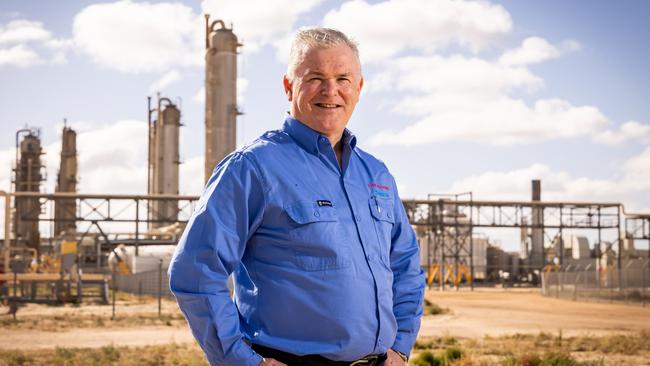Santos and Beach Energy sign off on $220m Moomba carbon capture and storage plan
Santos will go ahead with one of the largest carbon capture and storage projects in the world, with the $220m project set to start operating in 2024.

Santos has signed off on its $220m Moomba carbon capture and storage project with the go ahead on what will be one of the largest carbon storage projects in the world to be announced overnight at the COP26 climate change conference in Glasgow.
The Santos board, along with one third joint venture partner Beach Energy, late Monday took a final investment decision to go ahead with the project, which will be announced at the conference by Santos managing director Kevin Gallagher and federal Minister for Energy and Emissions Reduction Angus Taylor.
The Moomba CCS project is expected to create about 230 jobs during the construction phase and store about 1.7 million tonnes of carbon dioxide per year in depleted oil and gas reservoirs in South Australia’s Far North.
Santos has been close to making a decision on Moomba CCS for much of this year, but was waiting for CCS projects to be eligible for Australian Carbon Credit Units in order to make it more financially viable.
With the project now registered for credits with the Clean Energy Regulator, Mr Gallagher said it was all systems go for the globally-significant project.
“This carbon reduction project in the South Australian outback will be one of the biggest and lowest cost in the world and will safely and permanently story 1.7 million tonnes of carbon dioxide per year in the same reservoirs that held oil and gas for in place for tens of millions of years,’’ Mr Gallagher said.
“We forecast a full-life cycle cost of less than $US24 per tonne of CO2 including cash costs in operation of $US6-8 per tonne of CO2, with first injection targeted for 2024.
“This decision is a critical step in decarbonising natural gas on our path to new low-emissions and clean burning fuels such as hydrogen.’’
Santos has been talking about the possibility of using depleted reservoirs in the Cooper Basin to store carbon dioxide since at least 2008, when former chief executive David Knox suggested a facility could be up and running as soon as 2010 - with a helping hand in the form of a carbon price or a supportive financial instrument.
That did not eventuate at the time, and the company put the project effectively on ice for many years, but revitalised it in recent times, carrying out a successful injection test late last year which stored about 100 tonnes of CO2 underground.
The company now says that CCS can be part of a transition to the use of hydrogen as an energy source, with CO2 able to be stripped out of natural gas for sequestration, and the resulting hydrogen used.
Mr Gallagher said that without a viable solution to decarbonising fossil fuels, net zero was unachievable.
“If we do not decarbonise the hydrocarbon fuels that still make up just over 80 per cent of global primary energy and provide 60 per cent of the world’s clothing fibres along with other essential everyday products, then the world will simply not reach net-zero by 2050,’’ he said.
“2050 is only 30 years away and over the last 30 years since the first climate change conference in 1992, the world’s consumption of hydrocarbon fuels has increased in absolute terms and decreased by only 4 per cent in terms of primary energy share.’’
Mr Gallagher said the company was already receiving strong international interest in its CCS and hydrogen plans.
“Just as Australian LNG is valued in Asian markets without their own energy resources, carbon storage is now valued because many other countries lack the geological storage or land required for nature-based offsets,’’ he said.
“Australia has a comparative advantage in carbon storage and the Australian Government’s focus on CCS and other low-emission technologies is setting the nation up to capitalise on our natural assets and become a carbon storage superpower, building on the position we have established as an energy superpower over more than half a century.’’
Mr Gallagher has previously told The Australian that part of the rationale for the company’s $22bn merger with Oil Search, which is expected to be finalised next month, was to achieve the scale needed to fund the transition to a decarbonised world.
“You’ve got to be able to fund your growth activities, and the energy transition itself will be very expensive, it’s going to be very capital-intensive,’’ he said.
“And so, while you’re going through that energy transition, companies that are small and on their own and maybe don’t have a great ESG pathway will struggle to raise capital.
“If you don’t have the balance sheet or the ESG credentials, capital will either be unavailable to you or it will be expensive capital which will mean that transition is slower.
“It’s a vicious cycle.’’





To join the conversation, please log in. Don't have an account? Register
Join the conversation, you are commenting as Logout